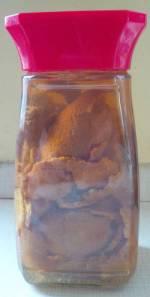The Whale Shark
Mighty, Mysterious, and Majestic
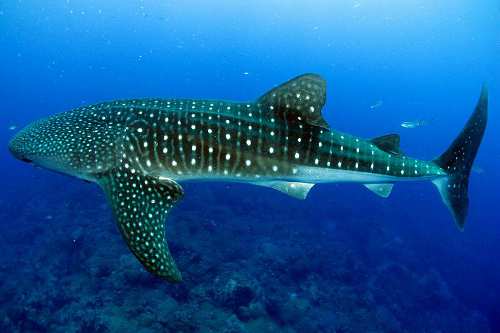
|
The Whale shark, or Rhincodon typus, belongs to the order Orectolobiformes and is the only species in the Rhincodontidae family. And having a family all to itself is not the only thing that makes this magnificent creature stand out from the crowd. This huge being is not only the largest shark, but also the largest fish
in the ocean. Now, you might think an animal this size would be fairly
easy for researchers to keep an eye on, but apparently not. |
|
The truth is, very little is known about this beautiful animal.
Size
At birth pups are between 55 and 65cm in length. Mature males average about 6m and females about 8m, though it is suspected that they can grow much larger.
The largest one ever caught was just under 13m long and weighed over 20 tonnes though there have been reported sightings of sharks up to 18m.
Colouring
The markings of the whale shark are unmistakable. Their dorsal, or upper side, varies in colour from greenish-brown to bluish or grey with a chequerboard-like pattern of pale yellow, grey or white spots.
The ventral, or under side, is white.
Fins
The first dorsal fin is set a little further back than midway and is a tall, roughly equal-sided triangular shape. A small pair of pelvic fins are located underneath it.
The second dorsal fin is about half the size and situated directly above a slightly smaller anal fin.
The pectoral fins are wide at the base and taper as they sweep towards the rear. The caudal fin has a slightly longer upper lobe in adults, though in juveniles it can be almost twice the length of the lower one.
They have prominent ridges running the length of their bodies, the lowest one forming strong caudal keels on the caudal peduncle.
Teeth
The teeth are small and not particularly well developed, but what they lack in stature, they certainly make up for in numbers. They can have as many as 300 to 350 rows of teeth.
Diet
This huge animal feeds on the tiniest of sea creatures, zooplankton. It also eats eggs and sperm during mass spawning of both fish and coral.
It feeds either by swimming with its huge mouth wide open forcing water and food into its mouth (ram filtration), or by sucking in huge volumes of water by opening and closing the mouth (active suction).
The water is then pushed out through the gills and the food is sieved out through the gill rakers.
Reproduction
These sharks are ovoviviparous and give birth to large numbers of pups. One female, harpooned off the coast of Taiwan, was found to have 300 developing young in her uterus. The gestation period and breeding cycle is unknown.
Distribution
Whale sharks like warmer water and are found worldwide in sea temperatures of about 20 to 30ºC. They are a migratory species and are known to migrate to fish and coral spawning grounds to feed.
They're pelagic so are found mostly in the open ocean or just offshore, but are known to come inshore at times.
They range from the surface to depths of about 700m.
Whale Shark Distribution Map
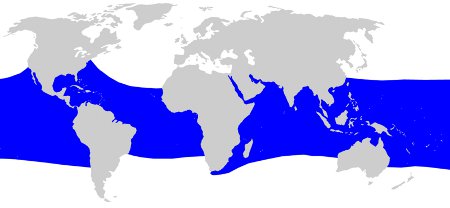
Known as the gentle giant of the ocean, the whale shark poses no threat to humans. The most common injury being an accidental whack from the huge tail fin.
It's my dream to, one day, freedive with these magnificent creatures. Watch the video below and you'll probably be adding it to your bucket list too.
Return to World of Sharks from Whale Shark
Classification
Phylum: Chordata
Class: Chondrichthyes
Subclass: Elsamobranchii
Order: Orectolobiformes
Family: Rhincodontidae
Genus: Rhincodon
Species: typus
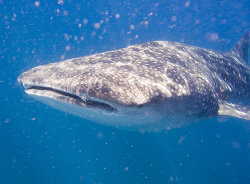
The whale shark's mouth can be up to 1,5m across!
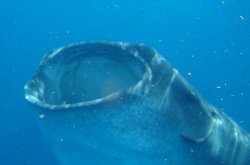
Whale shark feeding on plankton.
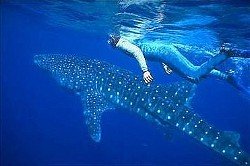
Snorkelling with a whale shark.
Recent Articles
-
Thresher Sharks
Aug 27, 14 10:51 AM
Thresher sharks are unmistakable with that huge upper lobe on the caudal fin. Let's find out more about them. -
Sharkwater
Aug 14, 14 12:42 PM
Sharkwater is a documentary by Rob Stewart highlighting the plight of the sharks in our oceans. -
Natural Cleaners
Aug 13, 14 08:57 AM
Natural cleaners and homemade skincare products are not only better for the environment, they're better for you and your family.
